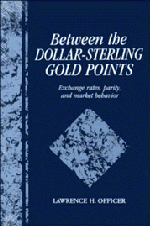
-
Select format
-
- Publisher:
- Cambridge University Press
- Publication date:
- October 2009
- May 1996
- ISBN:
- 9780511559723
- 9780521038218
- Dimensions:
- Weight & Pages:
- Dimensions:
- (228 x 152 mm)
- Weight & Pages:
- 0.551kg, 368 Pages
- Subjects:
- Economics, Macroeconomics, History, Finance and Accountancy, Economic History
- Series:
- Studies in Macroeconomic History
You may already have access via personal or institutional login- Subjects:
- Economics, Macroeconomics, History, Finance and Accountancy, Economic History
- Series:
- Studies in Macroeconomic History
Book description
Officer begins this book with a historical perspective of the monetary standards of the United States and Britain. He then develops data on exchange rates, mint parity and gold points, with which he investigates three important features of Anglo-American monetary history. First, the integration of the American foreign-exchange market over time. Second, it is proved that gold-point arbitrage is markedly more efficient than either interest arbitrage or forward speculation. Third, regime efficiency is explored from standpoints of both private agents and policy-makers; the 1925–1931 gold standard, though less durable than the pre-war standard, is nevertheless shown to be surprisingly stable. The book will serve as a Dollar-Sterling handbook for those interested in this important aspect of international monetary history.
Reviews
‘Students of Dollar-Sterling exchange rates will find this book to be a superb US-British financial history of the period 1791–1931 as well as an original statistical and analytic study of how the gold standard worked.’
Anna J. Schwartz - National Bureau of Economic Research
‘… the book is a beautiful example of the best kind of analysis of market micro-structure, and deserves to be on the shelves of any serious student of the history of the dollar-sterling exchange rate.’
Source: The Economic Journal
Contents
Metrics
Altmetric attention score
Full text views
Full text views help Loading metrics...
Loading metrics...
* Views captured on Cambridge Core between #date#. This data will be updated every 24 hours.
Usage data cannot currently be displayed.
Accessibility standard: Unknown
Why this information is here
This section outlines the accessibility features of this content - including support for screen readers, full keyboard navigation and high-contrast display options. This may not be relevant for you.
Accessibility Information
Accessibility compliance for the PDF of this book is currently unknown and may be updated in the future.


